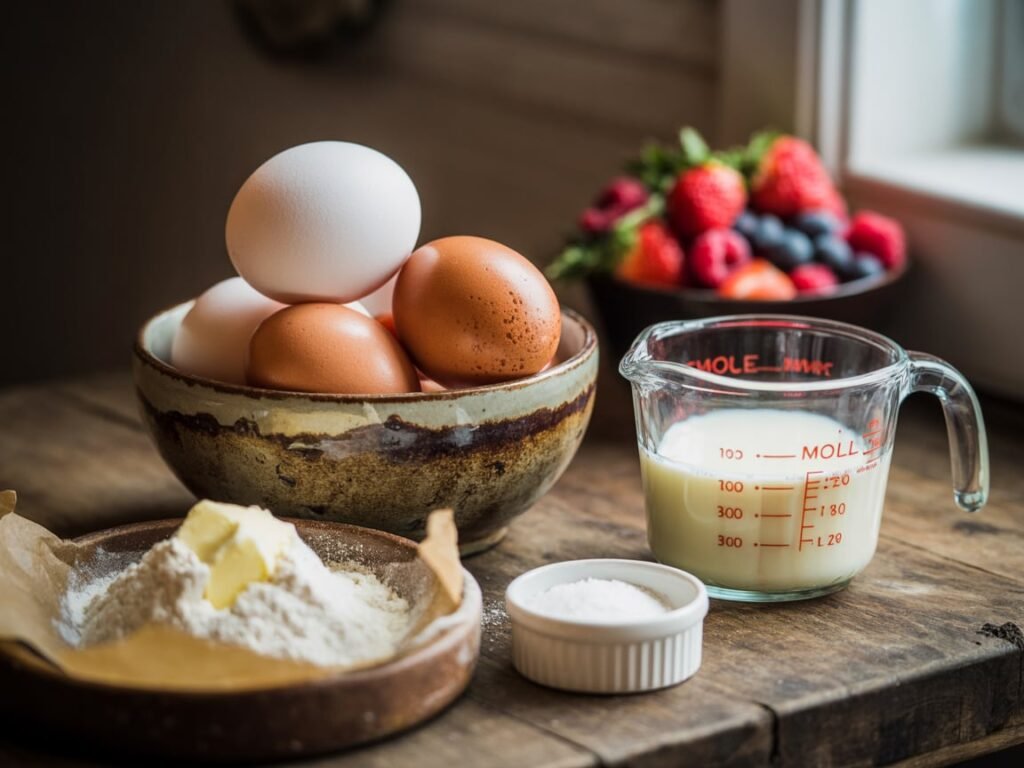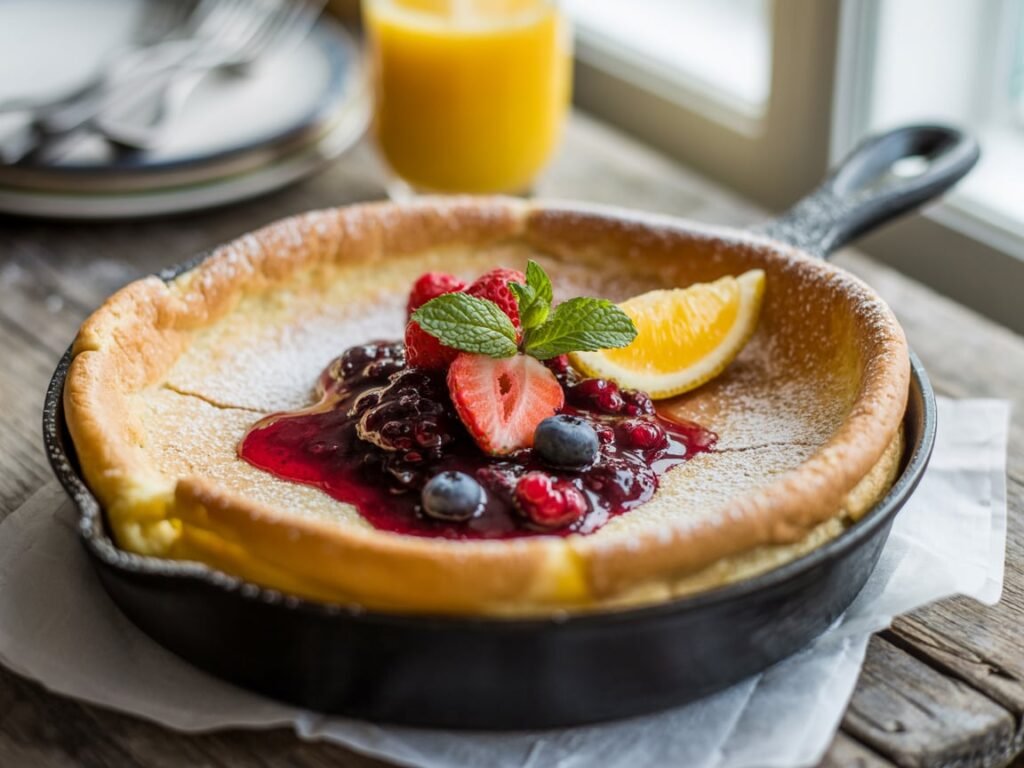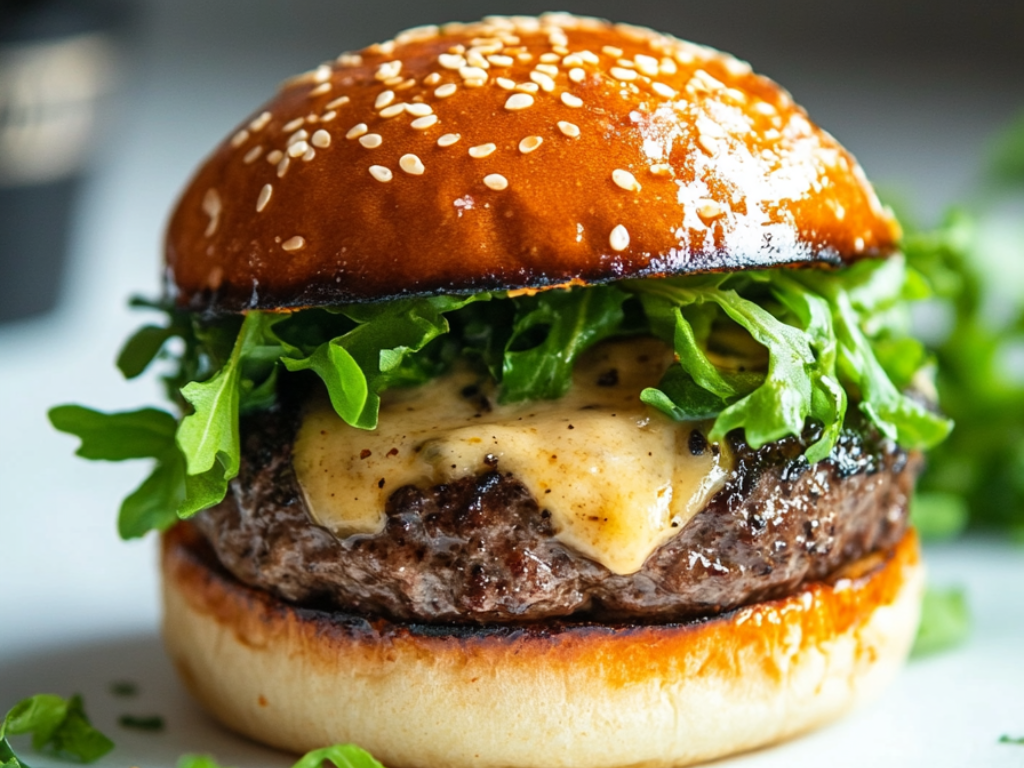A Culinary Ode to Simplicity and Splendor
This recipe is born from countless mornings spent in my cozy Vermont kitchen, where the chill of dawn demanded something warm, comforting, and effortlessly impressive. The Baked German Pancake delivers on all fronts: it’s quick to prepare, visually stunning, and endlessly adaptable. Whether you’re hosting a leisurely brunch or seeking a special breakfast for your family, this dish promises to delight with its airy fruit topping texture and rich, buttery flavor.
What sets this pancake apart from its skillet-fried cousins is its dramatic rise in the oven, a spectacle that never fails to captivate. The batter, a simple blend of eggs, flour, and milk, transforms into a golden vessel that cradles a medley of seasonal fruits and a dusting of powdered sugar. In this recipe, I’ve chosen to pair the pancake with a vibrant berry compote, but the beauty of this dish lies in its versatility—swap in caramelized apples, sautéed peaches, or even a drizzle of chocolate for a personalized touch.
As we embark on this culinary journey, I invite you to embrace the process with curiosity and joy. Cooking is as much about the experience as it is about the result, and this Baked German Pancake offers both in abundance. Let’s gather our ingredients, preheat the oven, and create a dish that’s as memorable as it is delicious.
The Philosophy of the Baked Pancake
At its core, the Baked German Pancake is a study in contrasts: rustic yet refined, simple yet show-stopping. Its origins are debated—some trace it to German immigrants in America, others to the traditional Apfelpfannkuchen of Germany—but its appeal is universal. The dish requires only a handful of pantry staples, yet the result feels like a labor of love. As a chef, I’ve always been drawn to recipes that achieve such alchemy, turning the ordinary into the extraordinary with minimal fuss.
This pancake is also a testament to the power of technique. The high oven heat and the hot skillet work together to create the pancake’s signature puff, while the balance of eggs and flour ensures a tender, custardy interior. The key is to trust the process: resist the urge to open the oven door as the pancake rises, and let the magic unfold.
In crafting this recipe, I’ve drawn on my years of experimenting with batters and toppings, refining the ratios to achieve the perfect texture and flavor. The addition of a touch of vanilla and a hint of cinnamon in the batter elevates the dish without overwhelming its simplicity, while the berry compote adds a bright, tangy counterpoint to the richness of the pancake.
A Note on Ingredients: Quality and Flexibility
The beauty of the Baked German Pancake lies in its reliance on basic ingredients, but the quality of those ingredients can make a significant difference. Here’s a closer look at what you’ll need and how to choose wisely.
Eggs: The Backbone of the Batter
Eggs are the heart of this dish, providing structure and richness. Use large, fresh eggs for the best results—their higher protein content helps the pancake rise and set properly. If possible, opt for eggs from a local farm; their vibrant yolks will lend a deeper color and flavor to the batter.
Flour: The Silent Supporter
All-purpose flour is the ideal choice for this recipe, offering the right balance of protein and starch. Too much flour can make the pancake dense, so measure carefully using the spoon-and-level method. For a slightly nuttier flavor, you can substitute up to a quarter of the flour with whole wheat or spelt flour, but be cautious not to overdo it, as this can affect the pancake’s rise.
Milk: The Key to Tenderness
Whole milk is preferred for its richness, which contributes to the pancake’s custardy texture. However, 2% milk or even plant-based alternatives like oat or almond milk can work in a pinch. If using a non-dairy milk, choose an unsweetened variety to avoid altering the flavor profile.
Butter: The Flavor Enhancer
Unsalted butter is essential for greasing the skillet and adding a rich, nutty flavor to the pancake. Use high-quality butter with a high fat content (at least 82%) for the best results. When melting the butter in the skillet, watch closely to ensure it doesn’t brown too much, as this can impart a bitter note.
Sugar and Spices: The Subtle Elevators
A small amount of granulated sugar in the batter enhances the pancake’s flavor without making it overly sweet. Vanilla extract and a pinch of ground cinnamon add warmth and depth, making the pancake feel indulgent without overpowering the fruit topping.
Berries: The Vibrant Crown
For the compote, I recommend a mix of fresh strawberries, blueberries, and raspberries. Their varied colors and flavors create a stunning and delicious topping. If fresh berries are out of season, frozen berries work well—just thaw and drain them to avoid excess moisture. Feel free to experiment with other fruits, such as sliced peaches or cherries, depending on availability.

The Essential Equipment: Tools for Success
This recipe requires minimal equipment, but the right tools will ensure flawless results:
- A 10-inch cast-iron skillet – The heavy, heat-retaining properties of cast iron are ideal for creating the pancake’s dramatic puff. A well-seasoned skillet also prevents sticking. If you don’t have cast iron, an oven-safe stainless steel or ceramic skillet can work, but avoid non-stick pans, as they may not conduct heat as effectively.
- A blender or whisk – A blender ensures a smooth, lump-free batter in seconds, but a whisk and some elbow grease will do the job just as well. If whisking by hand, be thorough to incorporate air into the batter.
- A heat-resistant spatula – For gently loosening the pancake from the skillet after baking.
- A small saucepan – For preparing the berry compote. Choose one with a heavy bottom to prevent scorching.
- Measuring cups and spoons – Precision is key for the batter, so use accurate tools to measure ingredients.
The Complete Ingredients List
For the Baked German Pancake (serves 4):
- 3 large eggs, at room temperature
- ¾ cup whole milk, at room temperature
- ¾ cup all-purpose flour
- 2 tablespoons granulated sugar
- 1 teaspoon pure vanilla extract
- ¼ teaspoon ground cinnamon
- ¼ teaspoon sea salt
- 3 tablespoons unsalted butter
For the Berry Compote:
- 1 cup fresh strawberries, hulled and halved
- ½ cup fresh blueberries
- ½ cup fresh raspberries
- ¼ cup granulated sugar
- 1 tablespoon fresh lemon juice
- 1 teaspoon cornstarch mixed with 1 tablespoon water (optional, for thickening)
For Serving:
- Powdered sugar, for dusting
- Fresh lemon wedges, for squeezing (optional)
- Whipped cream or Greek yogurt (optional)

The Method: A Step-by-Step Journey
Preparation Phase
Begin by setting the stage for success. Preheat your oven to 425°F (220°C) and place a 10-inch cast-iron skillet on the middle rack to heat along with the oven. A hot skillet is crucial for achieving the pancake’s signature rise, so allow at least 15 minutes for it to reach the proper temperature.
While the oven heats, prepare your ingredients. Room-temperature eggs and milk blend more smoothly and help the batter rise, so if they’re cold, let them sit out for 20-30 minutes or warm them gently by placing the eggs in a bowl of warm water and microwaving the milk in 10-second bursts until just warm.
Crafting the Batter: The Foundation
The batter is the soul of the Baked German Pancake, and its simplicity belies its transformative power. In a blender, combine the eggs, milk, flour, sugar, vanilla extract, cinnamon, and salt. Blend on medium speed for 20-30 seconds, until the mixture is smooth and frothy. Scrape down the sides of the blender to ensure no flour pockets remain.
If using a whisk, start by beating the eggs in a large bowl until frothy. Gradually whisk in the milk, followed by the sugar, vanilla, cinnamon, and salt. Sift the flour into the bowl and whisk gently until just combined, taking care not to overmix, as this can deflate the batter.
Let the batter rest for 5-10 minutes. This brief pause allows the flour to hydrate fully, resulting in a smoother texture and better rise.
Heating the Skillet: The Crucial Step
Carefully remove the hot skillet from the oven using oven mitts and place it on a heat-resistant surface. Add the butter to the skillet, swirling it to coat the bottom and sides as it melts. The butter should sizzle and foam but not brown excessively—if it starts to brown, work quickly to avoid burning.
Pour the batter into the center of the hot skillet, allowing it to spread naturally. The sizzling sound is a good sign; it means the batter is beginning to set and rise immediately.
Baking: The Transformation
Return the skillet to the oven and bake for 18-22 minutes, or until the pancake is puffed up, golden brown, and set in the center. Resist the urge to open the oven door during the first 15 minutes, as this can cause the pancake to deflate. The edges should rise dramatically, creating a rustic, crater-like shape with a tender center.
Preparing the Berry Compote: The Vibrant Finish
While the pancake bakes, prepare the berry compote. In a small saucepan, combine the strawberries, blueberries, raspberries, sugar, and lemon juice. Cook over medium heat, stirring gently, until the berries release their juices and the sugar dissolves, about 5-7 minutes.
For a thicker compote, stir in the cornstarch slurry and cook for an additional 1-2 minutes, until the mixture thickens slightly. Remove from heat and let cool slightly; the compote will continue to thicken as it sits.
Serving: The Grand Reveal
Remove the pancake from the oven and marvel at its golden, puffed-up glory. The edges will begin to deflate slightly as it cools, which is perfectly normal. Use a heat-resistant spatula to gently loosen the pancake from the skillet, then transfer it to a serving platter or serve it directly from the skillet for a rustic presentation.
Dust the pancake generously with powdered sugar, letting it settle into the folds and crevices. Spoon the warm berry compote over the top, allowing the vibrant juices to cascade down the sides. For an extra touch of brightness, serve with lemon wedges for squeezing or a dollop of whipped cream or Greek yogurt.
Serving Suggestions and Accompaniments
The Baked German Pancake is a versatile dish that shines as the centerpiece of a breakfast or brunch spread. Here are a few ways to elevate the experience:
- A side of bacon or sausage – The smoky, savory flavors complement the pancake’s subtle sweetness.
- A fresh fruit salad – A mix of citrus, melon, and kiwi adds color and refreshment.
- A hot beverage – Pair with freshly brewed coffee, a spiced chai latte, or a pot of Earl Grey tea.
- A savory twist – For a less traditional approach, top with crumbled bacon and a drizzle of maple syrup.
Adaptations and Variations: Making It Your Own
The Baked German Pancake is a canvas for creativity. Here are a few ways to adapt the recipe to suit your tastes or the seasons:
Seasonal Twists
- Spring: Top with a rhubarb and strawberry compote and a dollop of whipped cream.
- Summer: Use fresh peaches and a drizzle of honey for a sunny, sweet topping.
- Autumn: Sauté apples with cinnamon and brown sugar for a cozy, fall-inspired version.
- Winter: Add a chocolate-hazelnut spread and toasted nuts for a decadent treat.
Flavor Enhancements
- Citrus Zest: Add the zest of one lemon or orange to the batter for a bright, aromatic note.
- Spiced Batter: Incorporate a pinch of nutmeg or cardamom for a warm, complex flavor.
- Savory Version: Omit the sugar and top with sautéed mushrooms, herbs, and a sprinkle of Parmesan.
Make-Ahead and Storage Tips
While the Baked German Pancake is best enjoyed fresh, you can streamline the process for busy mornings:
- Make-Ahead Batter: Prepare the batter up to 24 hours in advance and store it in an airtight container in the refrigerator. Whisk briefly before using to reincorporate.
- Compote Storage: Make the berry compote up to 3 days ahead and store in the fridge. Reheat gently before serving.
- Leftovers: Store any leftover pancake in an airtight container in the refrigerator for up to 2 days. Reheat in a 325°F oven for 5-7 minutes to restore texture.
A Final Reflection on Joy and Connection
As I write this recipe, I’m reminded of the mornings when I’ve served this Baked German Pancake to loved ones, watching their faces light up at the sight of its golden, puffed-up splendor. There’s something deeply satisfying about a dish that requires so little yet delivers so much—both in flavor and in the memories it creates.
In a world that often feels hurried and fragmented, this pancake invites us to slow down, to gather around the table, and to savor the simple pleasures of a shared meal. It’s a reminder that the act of cooking, no matter how humble, is an act of love—a way to nourish not just our bodies but our connections with one another.
So, as you prepare this Baked German Pancake, I encourage you to embrace the process fully. Let the aroma of melting butter and baking batter fill your kitchen. Watch with delight as the pancake rises in the oven. And when you take that first bite, let it be a moment of pure, unadulterated joy.
Guten Appetit!

Nutritional Information (Per Serving)
- Calories: 280
- Protein: 8g
- Carbohydrates: 30g
- Fat: 14g (7g saturated)
- Fiber: 2g
- Sodium: 220mg
Note: Nutritional values are approximate and may vary based on specific ingredients and brands used.





Im curious, do you think the simplicity of the baked German pancake is enhanced or diminished by using high-end ingredients? Does quality overshadow simplicity, or does it elevate it?
While I appreciate the perspective on the philosophy of the baked pancake, dont you think its a bit of a stretch to call eggs the backbone of the batter? Without flour, its just a glorified omelette.
While the article beautifully glorifies the simplicity of Baked German Pancake, Im curious if its flexible enough to experiment using vegan substitutes, especially for eggs? Would it still hold its philosophical splendor?
While I agree that eggs are indeed the backbone of the batter, I wonder if the author has ever considered vegan alternatives? Baked German pancakes could be just as splendid with a well-executed flaxseed replacement.
Interesting read! But, wouldnt you agree that even though eggs are the backbone of the batter, the quality of flour too plays a significant role in the pancakes texture?
Isnt the real splendor of the German pancake its ability to adapt to any filling?
Isnt the splendor of simplicity in baked pancakes the true essence of cooking?
So, are the eggs cage-free or not? The pancakes soul depends on it!